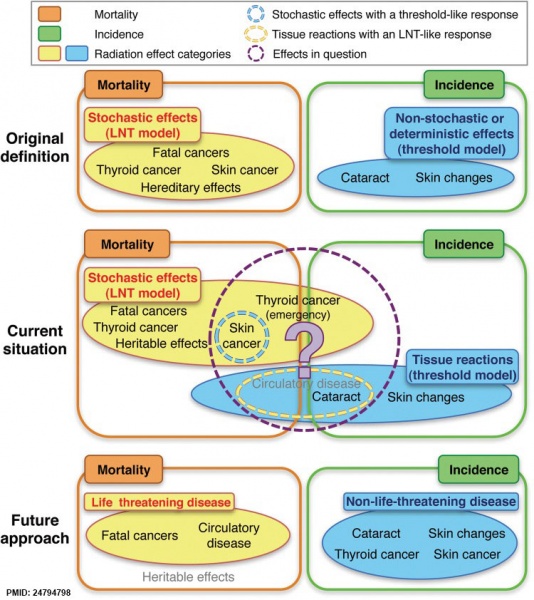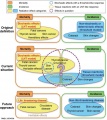File:Proposed radiation effect classification.jpg

Original file (750 × 842 pixels, file size: 162 KB, MIME type: image/jpeg)
Proposed Radiation Effect Classification
A diagram schematizing the original definition, current situation and the reference authors proposal for radiation effect classification and associated radiation protection (RP) endpoints.
- Orange- and green-colored solid lines indicate radiation effects of which risk is managed in terms of mortality and incidence, respectively.
- Yellow- and blue-colored solid areas represent radiation effect categories.
- Yellow-colored dotted line shows radiation effects categorized in tissue reactions but with a linear-non-threshold (LNT)-like dose response.
- Blue-colored dotted line shows radiation effects categorized in stochastic effects but with a threshold-like dose response.
- A purple-colored dotted line further emphasizes radiation effects that obscure the boundary between stochastic effects and tissue reactions.
Radiation effects were originally classified into stochastic effects and non-stochastic or deterministic effects (presently called tissue reactions). Stochastic effects comprise fatal cancer, non-fatal cancer (e.g. thyroid cancer and non-melanoma skin cancer) and fatal hereditary effects with an LNT dose–response model, whilst a threshold-like dose–response relationship has been known for several cancers such as skin cancer and bone cancer. Non-stochastic or deterministic effects include radiation effects with a threshold-type dose–response model (e.g. vision-impairing cataracts and cosmetically unacceptable non-cancer skin changes). For RP purposes, mortality and incidence were endpoints employed to manage the risk of stochastic effects and non-stochastic or deterministic effects, respectively, whereas an ‘emergency dose level’ for the thyroid was assigned based on its cancer incidence. At present, these have not been changed basically. However, a tissue reaction category now includes life-threatening circulatory disease, though its dose limit has not been set. Moreover, for cataracts and circulatory disease, epidemiological evidence now suggests an LNT dose response, and the RP system assumes no dose-rate effect, making the boundary between stochastic effects and tissue reactions fuzzy. Such a situation may be improved if radiation effects are classified into life-threatening disease and non-life-threatening disease, for which the risk management endpoints are mortality and incidence, respectively. Taken together, the necessity to limit heritable effects should also be reconsidered because human evidence has thus far shown no detectable transgenerational effects. This approach may be useful for future discussion.
Reference
<pubmed>24794798 </pubmed>
doi: 10.1093/jrr/rru019
Copyright
© The Author 2014. Published by Oxford University Press on behalf of The Japan Radiation Research Society and Japanese Society for Radiation Oncology. This is an Open Access article distributed under the terms of the Creative Commons Attribution License (http://creativecommons.org/licenses/by/4.0/), which permits unrestricted reuse, distribution, and reproduction in any medium, provided the original work is properly cited.
File history
Click on a date/time to view the file as it appeared at that time.
| Date/Time | Thumbnail | Dimensions | User | Comment | |
|---|---|---|---|---|---|
| current | 08:01, 7 February 2016 |  | 750 × 842 (162 KB) | Z8600021 (talk | contribs) |
You cannot overwrite this file.
File usage
The following page uses this file: